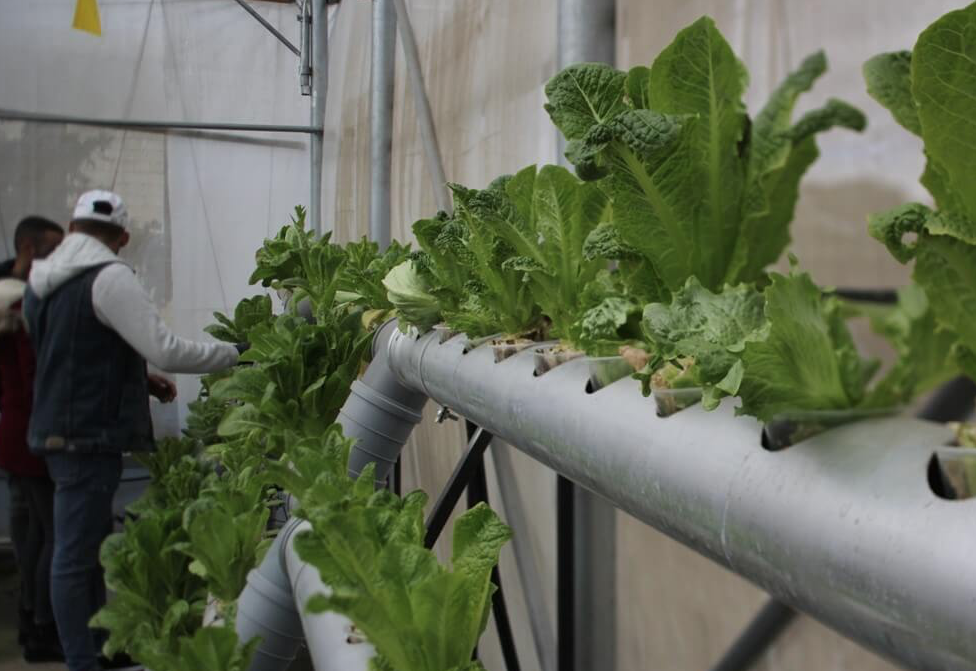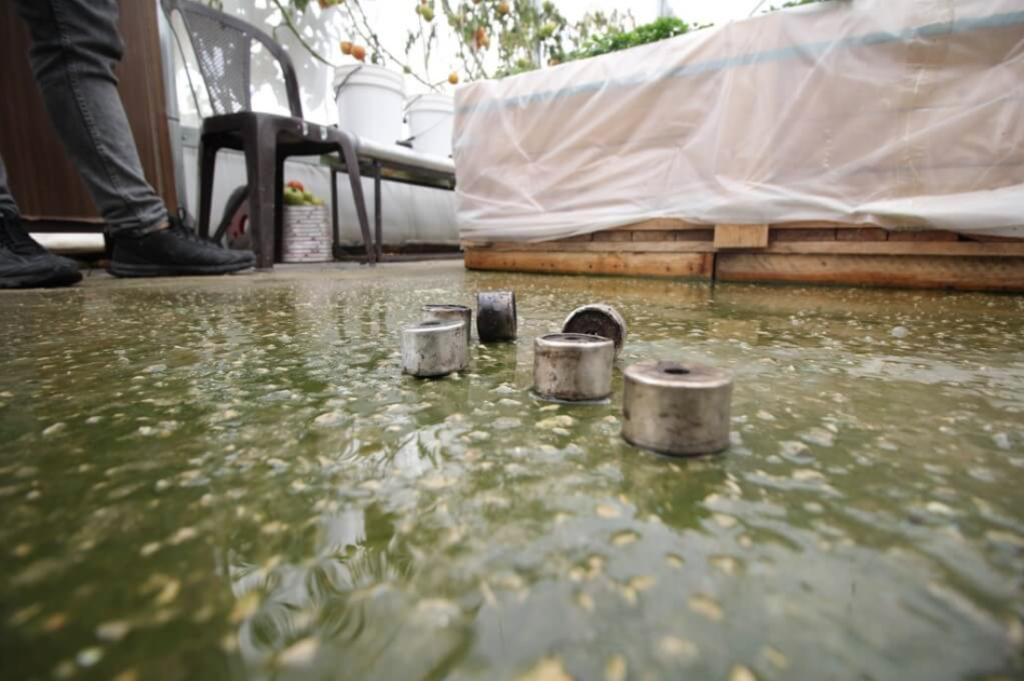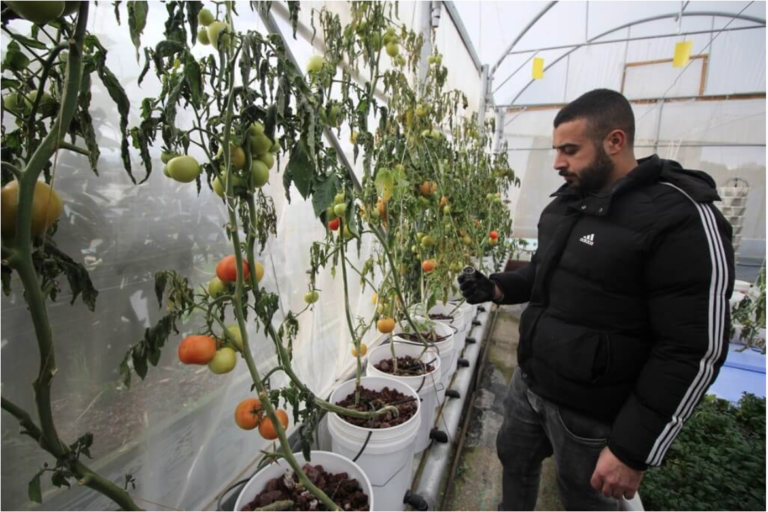At 7:00pm local time on Tuesday 18th January, the Israeli Defense Forces initiated an attack on Aida Refugee Camp in Bethlehem, Palestine. The attack, lasting 20 minutes according to eyewitnesses, was after dark, in empty streets and unprovoked, launched from a military base that overlooks the camp. It impacted Lajee Center, a youth and community organization that houses a kindergarten, a hydroponics garden, a library, and more and that is located near the military base. The hydroponics vegetable farm on the roof of the building was damaged, with 1,000 seedlings destroyed. The children’s playground adjoining the newly opened kindergarten was also damaged.
Since the weather was cold, windows were closed and people inside the nearby houses were not physically harmed, but dense clouds of tear gas settled around the houses and streets in the lower elevations of the camp. The next morning, staff and volunteers of Lajee Center assessed the damage and collected over 150 spent canisters in and around the building. Canisters can also burn surfaces where they settle. Burn marks scarred the street and the ground in many places.
Asked what could have provoked this attack staff members of Lajee Center could only conjecture. According to those who saw military vehicles approaching, the canister launchers appeared to be a new model. Perhaps they were testing this new equipment? Perhaps this was a collective punishment for some transgression remote in time and place? Perhaps it was bored soldiers doing this for ‘fun’? Or perhaps it was just another reminder of who is the boss. There is no definitive explanation for motive since the IDF feels under no obligation to provide one.
Asked about the hydroponics unit, Shatha Al-Azzah, director of the health and environmental programs at the Lajee Center, says that the rooftop farm, established in 2021, serves about 120 families, 800 people altogether, providing them with fruit and vegetables. There is no open space in the dense and congested camp established by the United Nations following the ‘Nakba’ (Catastrophe) that drove 750,000 people from their homes at the establishment of the state of Israel in 1948. In Aida Camp alone, more than 70 years later, families from 27 destroyed and evacuated villages remain in the camp as refugees. In addition to feeding the families, the farm offers an opportunity for an older generation knowledgeable in raising crops to work with younger generations keen to adopt this new technique that uses 70% less water than traditional methods of raising garden produce. The range of crops, including tomato, parsley, mints, lettuce, strawberry, and onions, all 100% chemical-free and organic, has been developed in conjunction with Lajee’s community health program to encourage healthier diets.
Surveying the burned plastic roof canopy and shriveled plants, Shatha says the system has to be thoroughly cleaned out to remove all traces of the toxic gas, which settled as dust on the ground, pools, and leaves of the garden. A new thick plastic shield needs to be put up, and around that a protective network to keep tear gas canisters from reaching the plastic. Then will come the replanting. Within a week or two she hopes to have planted new crops.
The kindergarten, Zahrat Al-Yasmeen (Jasmine Flower) School, opened last year to 50 students aged 4 to 6 in two classes. The curriculum is based loosely on the Reggio Emilia philosophy with particular attention paid to children raised in an environment of continuing stress and trauma. Included in the student cohort are children with physical and cognitive challenges, who are fully integrated into the activities of the school, guided by teachers with special training. The school has been a great success in the community, generating happy students and happy parents.
The classrooms themselves, as in any school, have been designed to be bright and airy with as much natural light and air as possible, and access to the outdoor playground. Anticipating the sort of attack that happened last Tuesday however, doors, windows, roller shutters, and ventilation have been designed to quickly close down and save the children from harm. The playground itself is harder to protect. Work will have to be done to repair or replace the shade canopies. Protocols will be rehearsed again and again, to ensure students can be brought quickly to safety. Families of the camp are used to the dangers of life under occupation. The day after the attack, all of the families sent their children to the kindergarten.
Both the kindergarten and the hydroponics garden are supported by 1for3.org, a Boston based organization working to advocate and build toward health, environment, and educational opportunities for Palestinian refugees. Working with Lajee Center, both organizations seek to nurture community strengths across multiple generations in the face of many threats from the occupation. Executive director Nidal Al-Azraq commented, “Our partners in Palestine are working on rebuilding as we speak, and this is an expression of Palestinian steadfastness and determination.”


The incident on Tuesday is not an isolated case. According to a report from the Human Rights Center of the School of Law at UC Berkeley,[1] Aida Camp is among the most intensely teargassed place on earth. Not only in Aida but throughout the West Bank and Gaza and even in Israel proper, the IDF and police have used tear gas and ‘skunk water’ (a vile liquid smelling of feces and putrefaction) to enforce the order of Occupation, liberally and over many years. Most of the tear gas is manufactured in the United States by companies such as Combined Systems Inc. and Federal Laboratories, both located in Pennsylvania, and there are many others.[2] Tear gas, CS gas, and their variants are classified as non-lethal weapons, although many deaths have been caused by this material. In 2014, Noha Qatamish, age 40, was suffocated by tear gas in her home in Aida Camp. The regulation of tear gas has been weak in form, ineffectual in practice. In the 1990s, the international Chemical Weapons Convention banned the use of tear gas in war, but reserved the right for individual countries to use it within their own countries. In 1991, a lawsuit was filed by 61 plaintiffs against Federal Laboratories and its parent company, TransTechnology Inc. in California for the injury and death of eight Palestinians who died as a direct result of tear gas assaults. So far there have been no awards for death or injury caused by tear gas.[3]
[1] University of California, Berkeley, “No Safe Space: Human Rights Consequences of Tear Gas Exposure Among Palestinian Refugees” (December 28, 2017)
[2] https://www.warresisters.org/tear-gas-not-nonlethal-ways-resist-us-tear-gas-shipments
[3] https://www.sciencedirect.com/topics/medicine-and-dentistry/tear-gas


